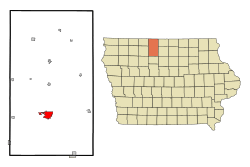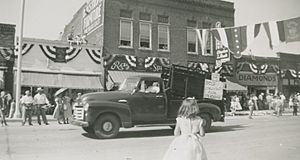Algona, Iowa facts for kids
Quick facts for kids
Algona, Iowa
|
|
|---|---|
|
Left, the Kossuth County Courthouse, right, the Henry Adams Building
|
|

Location of Algona, Iowa
|
|
| Country | |
| State | |
| County | Kossuth |
| Area | |
| • Total | 4.53 sq mi (11.74 km2) |
| • Land | 4.53 sq mi (11.72 km2) |
| • Water | 0.01 sq mi (0.02 km2) |
| Elevation | 1,194 ft (364 m) |
| Population
(2020)
|
|
| • Total | 5,487 |
| • Density | 1,212.52/sq mi (468.16/km2) |
| Time zone | UTC-6 (Central (CST)) |
| • Summer (DST) | UTC-5 (CDT) |
| ZIP code |
50511
|
| Area code(s) | 515 |
| FIPS code | 19-01135 |
| GNIS feature ID | 0454126 |
Algona is a city in Iowa, United States. It is the county seat of Kossuth County. In 2020, about 5,487 people lived there. You can find Ambrose A. Call State Park just two miles southwest of the city.
Contents
History of Algona
Algona was started in 1854. Its name comes from an Algonquian word meaning "Algonquin waters."
Early Education and Care
From 1869 to 1875, Algona was home to Algona College. This school was supported by the Methodist Church.
In 1894, Algona took part in the "Orphan Trains" project. Many children in New York City had no families. So, nearly 100,000 orphans were sent by train to live with new families across America. Algona welcomed almost 100 of these children. Many of them stayed in Algona for their whole lives.
Sports History
From 1902 to 1906, Algona had a special baseball team called the Algona Brownies. This team was made up of African American players. For the first two years, it was an interracial team, meaning it had both black and white players.
In 1903, the team was named the Western champions. After that year, the team became only black players. They won the Western championship again in their final year, 1906.
Famous Buildings
The Henry Adams Building is a famous building in Algona. It was designed by a well-known architect named Louis Sullivan in 1913. It is located at the corner of East State and Moore streets. Even though it wasn't built to be a bank, it's seen as one of Sullivan's "Jewel Boxes." These were a series of beautiful banks he designed.
World War II Camp
During World War II, Algona was the site of a German prisoner of war (POW) camp. From 1943 to 1946, about 10,000 prisoners were held at Camp Algona. Many of them worked on farms. These farms had family members fighting in the war overseas. Today, a museum remembers the camp's history. It even has a nativity scene made by the POWs.
1979 Tornado
On June 28, 1979, a very strong tornado hit Algona. It was an F3 tornado and sadly killed two people. The tornado caused a lot of damage to the main shopping area. Many homes were also destroyed. Luckily, people had about 15 minutes of warning. Tornado sirens sounded before it arrived. Also, it was still daylight, which helped keep the number of deaths low.
Giant Cheeto Puff
In 2003, Algona got national attention for something unusual. The city announced it had bought the world's largest Cheetos puff! A local radio DJ came up with the idea. He hoped it would bring tourists to the town to see the giant snack.
Geography
Algona is located along the East Fork Des Moines River.
The city covers about 4.51 square miles (11.74 km2). Most of this area is land, with only a small part being water.
Climate
| Climate data for Algona, Iowa, 1991–2020 normals, extremes 1893–present | |||||||||||||
|---|---|---|---|---|---|---|---|---|---|---|---|---|---|
| Month | Jan | Feb | Mar | Apr | May | Jun | Jul | Aug | Sep | Oct | Nov | Dec | Year |
| Record high °F (°C) | 66 (19) |
70 (21) |
87 (31) |
95 (35) |
106 (41) |
105 (41) |
108 (42) |
110 (43) |
100 (38) |
94 (34) |
81 (27) |
68 (20) |
110 (43) |
| Mean maximum °F (°C) | 43.9 (6.6) |
49.0 (9.4) |
68.2 (20.1) |
82.6 (28.1) |
89.6 (32.0) |
92.7 (33.7) |
91.9 (33.3) |
89.7 (32.1) |
88.6 (31.4) |
83.2 (28.4) |
66.5 (19.2) |
48.4 (9.1) |
95.3 (35.2) |
| Mean daily maximum °F (°C) | 24.9 (−3.9) |
29.3 (−1.5) |
42.7 (5.9) |
58.4 (14.7) |
70.5 (21.4) |
80.2 (26.8) |
83.1 (28.4) |
80.6 (27.0) |
75.2 (24.0) |
61.8 (16.6) |
44.7 (7.1) |
30.5 (−0.8) |
56.8 (13.8) |
| Daily mean °F (°C) | 15.4 (−9.2) |
19.8 (−6.8) |
32.6 (0.3) |
46.1 (7.8) |
58.5 (14.7) |
69.0 (20.6) |
72.1 (22.3) |
69.7 (20.9) |
62.6 (17.0) |
49.7 (9.8) |
34.3 (1.3) |
21.6 (−5.8) |
45.9 (7.7) |
| Mean daily minimum °F (°C) | 6.0 (−14.4) |
10.2 (−12.1) |
22.6 (−5.2) |
33.8 (1.0) |
46.5 (8.1) |
57.8 (14.3) |
61.2 (16.2) |
58.8 (14.9) |
50.1 (10.1) |
37.5 (3.1) |
23.9 (−4.5) |
12.8 (−10.7) |
35.1 (1.7) |
| Mean minimum °F (°C) | −15.2 (−26.2) |
−10.3 (−23.5) |
0.3 (−17.6) |
20.8 (−6.2) |
34.4 (1.3) |
47.0 (8.3) |
51.3 (10.7) |
49.3 (9.6) |
35.6 (2.0) |
21.9 (−5.6) |
6.3 (−14.3) |
−8.4 (−22.4) |
−17.9 (−27.7) |
| Record low °F (°C) | −35 (−37) |
−36 (−38) |
−25 (−32) |
6 (−14) |
21 (−6) |
35 (2) |
42 (6) |
37 (3) |
22 (−6) |
3 (−16) |
−17 (−27) |
−30 (−34) |
−36 (−38) |
| Average precipitation inches (mm) | 0.90 (23) |
1.04 (26) |
1.95 (50) |
3.36 (85) |
4.72 (120) |
5.49 (139) |
4.13 (105) |
4.27 (108) |
3.27 (83) |
2.44 (62) |
1.46 (37) |
1.06 (27) |
34.09 (865) |
| Average snowfall inches (cm) | 10.0 (25) |
10.3 (26) |
5.6 (14) |
1.8 (4.6) |
0.0 (0.0) |
0.0 (0.0) |
0.0 (0.0) |
0.0 (0.0) |
0.0 (0.0) |
0.3 (0.76) |
3.7 (9.4) |
9.8 (25) |
41.5 (104.76) |
| Average precipitation days (≥ 0.01 in) | 5.2 | 5.2 | 6.7 | 9.9 | 13.1 | 11.9 | 9.3 | 8.8 | 8.6 | 7.4 | 5.7 | 5.8 | 97.6 |
| Average snowy days (≥ 0.1 in) | 4.6 | 4.3 | 2.6 | 0.9 | 0.0 | 0.0 | 0.0 | 0.0 | 0.0 | 0.2 | 2.0 | 4.2 | 18.8 |
| Source 1: NOAA | |||||||||||||
| Source 2: National Weather Service | |||||||||||||
Population Data
| Historical populations | ||
|---|---|---|
| Year | Pop. | ±% |
| 1870 | 860 | — |
| 1880 | 1,359 | +58.0% |
| 1890 | 2,068 | +52.2% |
| 1900 | 2,911 | +40.8% |
| 1910 | 2,908 | −0.1% |
| 1920 | 3,724 | +28.1% |
| 1930 | 3,985 | +7.0% |
| 1940 | 4,954 | +24.3% |
| 1950 | 5,415 | +9.3% |
| 1960 | 5,702 | +5.3% |
| 1970 | 6,032 | +5.8% |
| 1980 | 6,289 | +4.3% |
| 1990 | 6,015 | −4.4% |
| 2000 | 5,741 | −4.6% |
| 2010 | 5,560 | −3.2% |
| 2020 | 5,487 | −1.3% |
| Source: and Iowa Data Center Source: |
||
The population of Algona has changed over the years. You can see the historical numbers in the table and graph above.
2020 Census Information
According to the census in 2020, Algona had 5,487 people. There were 2,429 households, which are groups of people living together.
Most of the people in Algona (91.0%) were White. About 0.8% were Black or African American, and 0.9% were Asian. About 6.3% of the population were Hispanic or Latino.
The average age in Algona was 45.6 years old. About 22.7% of the people were under 20 years old. Also, 26.1% were 65 years old or older. The city had slightly more females (51.9%) than males (48.1%).
Education
Algona has two main school systems.
- The Algona Community School District runs the public schools.
- Algona High School serves students from Algona and nearby towns.
- The public elementary schools are Lucia Wallace Elementary, Bryant Elementary, and Bertha Godfrey Elementary School.
- The Catholic school system includes:
- Bishop Garrigan High School, named after the first bishop of the Catholic Diocese of Sioux City.
- Seton Elementary, named after St. Elizabeth Ann Seton.
Utilities
Algona Municipal Utilities (AMU) provides services like water, electricity, cable, internet, and phone. A board of five people chosen by the mayor manages AMU.
- Drinking water comes from an underground source and is treated before it goes to homes.
- Wastewater is collected and cleaned.
- Electricity is bought from power plants in other cities and then sent to customers in Algona.
- AMU has offered cable, internet, and phone services since 1997.
Notable People
Many interesting people have come from Algona, including:
- Paul Bell – a politician
- Dick Dale – a singer who appeared on the Lawrence Welk TV show
- Lester Dickinson – a U.S. Representative and U.S. Senator from Iowa
- Steve Doocy – a co-host of Fox & Friends on Fox News
- Curt Hanson – an educator and politician
- Denis Menke – a Major League baseball player and coach
- Mike Mercer – a National Football League kicker and punter
- Brad Nelson – a Major League baseball player
- Mary Jane Odell – Iowa Secretary of State
- Elizabeth Bunnell Read – a journalist who supported women's right to vote
- Paul Seiler - played football in the American and National Football Leagues
- Eric Swalwell – a Congressman from Dublin, CA (his father was police chief in Algona)
- J.L. Wilkinson – owner of the Kansas City Monarchs baseball team, a member of the Baseball Hall of Fame
- Audi Crooks - a basketball player for Iowa State University
See also
 In Spanish: Algona (Iowa) para niños
In Spanish: Algona (Iowa) para niños






